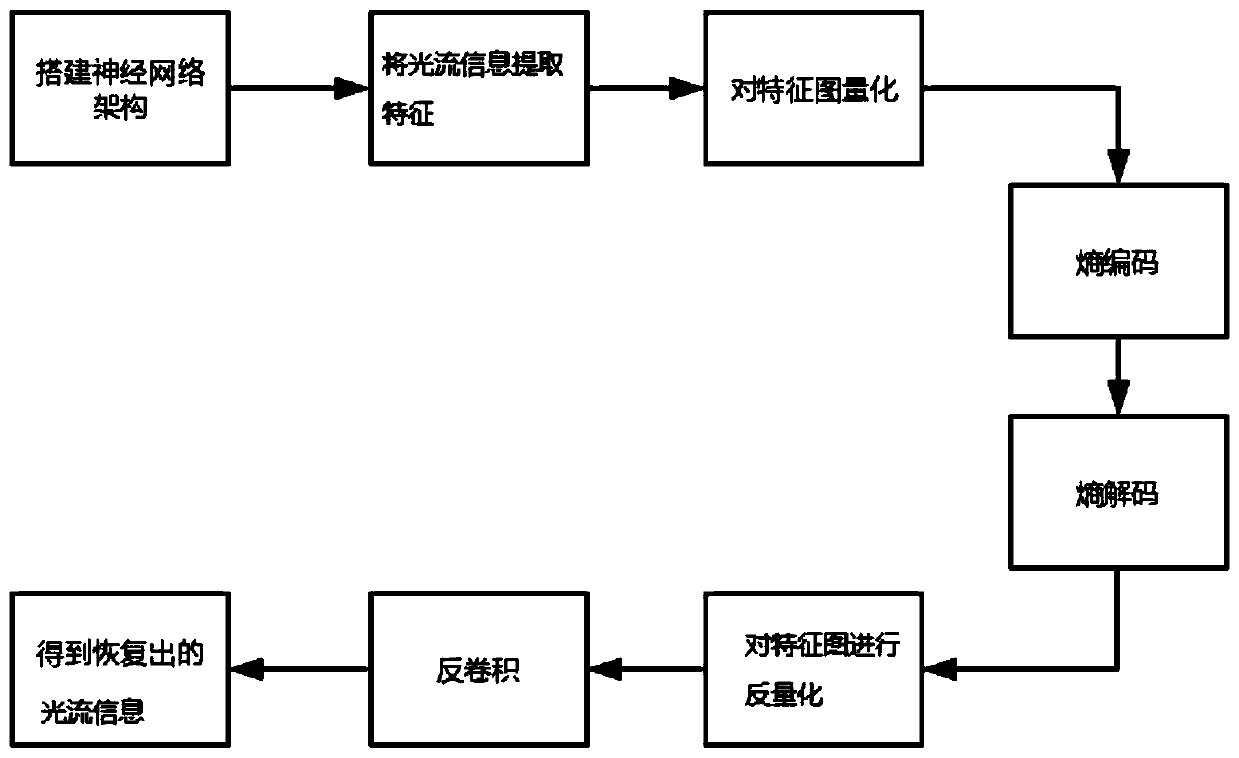Optical flow information compression method and device based on auto-encoder
A self-encoder and optical flow information technology, which is applied in the field of codec and information compression, to achieve the effect of optimizing storage space, reducing storage cost, and reducing storage space
- Summary
- Abstract
- Description
- Claims
- Application Information
AI Technical Summary
Problems solved by technology
Method used
Image
Examples
Embodiment 1
[0044] The optical flow information compression method based on an autoencoder of the present invention is to extract the optical flow features through a trained neural network model based on an autoencoder (Encoder), generate a feature map (Feature Map), and quantify (Quantize) Reduce the storage space of the data, and then use entropy coding to further encode and compress the quantized data; when decoding, the saved entropy coded data is entropy decoded and dequantized, and then passed through a decoder with the opposite structure (Decoder) Decoding, so that the feature map is restored to two-channel optical flow information; as attached figure 1 As shown, the details are as follows:
[0045] S1. Build a neural network model based on an autoencoder: set the number of convolutional layers required for encoding, the size of the convolutional kernel, the method of padding, and the number of strides; the design principle of the convolutional layer is usually the size of the conv...
Embodiment 2
[0055] The present invention mainly comprises encoder and decoder two parts, as attached figure 2 As shown, the specific workflow is as follows:
[0056] (1), the optical flow is input to the convolutional layer 1, convolutional layer 2 and convolutional layer 3 of the encoder for encoding to obtain a feature map;
[0057] Among them, the number of kernels (kernal) of the convolutional layer 1: 256, the size of the kernel number (kernal size): 9×9, the convolution step size (stride): 4, and the padding "SAME";
[0058] The number of kernels (kernal) of the convolutional layer 2: 192, the size of the kernel number (kernal size): 7×7, the convolution step size (stride): 2, the padding (padding) "SAME";
[0059] The number of kernels (kernal) of the convolutional layer 3: 128, the size of the kernel number (kernal size): 3×3, the convolution step size (stride): 2, padding (padding) "SAME";
[0060] (2), quantize and entropy encode the feature map;
[0061] (3), save the encod...
Embodiment 3
[0068] The optical flow information compression device based on the self-encoder of the present invention, the device includes,
[0069] The neural network model building unit is used to build the neural network model based on the autoencoder, and set the number of convolutional layers required for encoding, the size of the convolution kernel, the number of strides and the method of padding;
[0070] The training unit is used to use the training set to train the neural network model based on the autoencoder, set the label of each optical flow graph information to itself, construct the loss function through mse and bpp, and use the Adam optimizer to optimize. After the second iteration, the trained neural network model based on the autoencoder is obtained;
[0071] The feature map acquisition unit is used to encode the optical flow map information to obtain the feature map: input the optical flow map information to the Encoder part of the trained autoencoder-based neural networ...
PUM
 Login to View More
Login to View More Abstract
Description
Claims
Application Information
 Login to View More
Login to View More - Generate Ideas
- Intellectual Property
- Life Sciences
- Materials
- Tech Scout
- Unparalleled Data Quality
- Higher Quality Content
- 60% Fewer Hallucinations
Browse by: Latest US Patents, China's latest patents, Technical Efficacy Thesaurus, Application Domain, Technology Topic, Popular Technical Reports.
© 2025 PatSnap. All rights reserved.Legal|Privacy policy|Modern Slavery Act Transparency Statement|Sitemap|About US| Contact US: help@patsnap.com


